Citation: Gustavo Aguilar, Pranjali D. Muley, Charles Henkel, Dorin Boldor. Effects of biomass particle size on yield and composition of pyrolysis bio-oil derived from Chinese tallow tree (Triadica Sebifera L.) and energy cane (Saccharum complex) in an inductively heated reactor[J]. AIMS Energy, 2015, 3(4): 838-850. doi: 10.3934/energy.2015.4.838
The use of biomass as an energy source has been around for centuries, most commonly as a source of heat. In modern times, biomass still sees common usage as a heat source but current energy sources are dominated by the use of fossil fuels. While the supply of fossil fuels was considered abundant at one time [1], the reserves as a whole are finite. Irrespective of market volatility, these resources are dwindling as energy demand increases in today’s energy-dependent infrastructures and economies. A viable option for supplementing petroleum demands can be found by turning once again to biomass as a renewable energy feedstock [2].
Thermochemical conversion techniques have been demonstrated to be a feasible method for conversion of biomass to liquid fuels, including via pyrolysis of biomass in an induction heater [1]. Operating parameters for pyrolysis, a process performed at atmospheric pressure that yields a liquid fuel directly (as opposed to gasification), range from 300 to 700 °C and residence times of less than two seconds [3,4]. The major advantage over gasification and hydrothermal liquefaction is the direct production of liquid fuels and the lack of costly high pressure system, respectively, thus simplifying the reactor design [5]. When combined with proper upgrading and refining techniques, pyrolytic bio-oil has the potential to partially alleviate current petroleum oil and energy demands.
In the context of fuel conversion, biomass is commonly sourced from plants, either as a byproduct of harvesting, as a dedicated energy crop, or as an excess waste product after processing. The growth of dedicated biomass sources consumes carbon dioxide, therefore combustion of biomass based fuels produces a net zero increase of atmospheric CO2 [6]. Pyrolysis derived bio-oil also has a distinct advantage in being carbon neutral as well as having low sulfur and nitrogencontent [7]. Invasive species could also see use as potential feedstock. With invasive species costing millions of dollars in control methods to states such as Florida, with zero net gain, biofuel conversion offers a net gain from bio oil and by producing soil-enriching char [8] which would focus control methods and decrease costs while offering value added products. By using these existing biomasses, we can take advantage of a relatively untapped energy source for the production of a viable petroleum oil substitute and agriculture additive.
There are multiple factors that affect the efficiency of bio-oil production process such as, biomass type and particle size of biomass, pyrolysis temperature, reactor efficiency, chemical composition of the biomass and initial moisture content. While some of these factors have been studied extensively, the effects of particle size are only sparsely presented in the literature [9,10]. Some studies have accounted for particle size as a variable in optimizing bio-oil production [11,12,13,14,15] while others have used particle size as a way to isolate other variables, such as pellet compression effectiveness before pyrolysis [16]. Shen et al. studied the effect of different particle sizes on fast pyrolysis of Mallee woody biomass and concluded that particle size has a significant effect on the yield and composition of bio-oil [17]. Bennadji et al. studied the effect of particle size on low temperature pyrolysis of woody biomass, which yielded useful reaction kinetics data in the centimeter ranges of particle sizes [18].
The objective of this study was to investigate the effect of particle size on product yield and quality for fast pyrolysis of two different biomasses (energy cane and invasive Chinese tallow tree wood) using an induction-heating reactor. A key factor in the production of bio-oil is the type of feedstock fed into the pyrolysis system, as in the species of the biomass that is reacted. This study explored the use of energy cane bagasse (Saccharum complex) and Chinese tallow tree (Triadica sebifera L.) wood. Energy cane is a high fiber sugar cane hybrid of commercial and wild sugar cane varieties. Energy cane has a high tonnage of biomass per hectare by sacrificing fermentable sugars for high fiber content [19]. Chinese tallow tree is an invasive species found in the southern United States [2,20]. CTT seeds have oil content to up to 40%, which has a wide utilization in oils, varnishes, paints, and as a potential feedstock for the production of biodiesel [2,20,21]. Some attention has been given to the woody mass of the tree as a pyrolysis feedstock [22], and this study seeks to expand the understanding of the pyrolysis of Chinese tallow tree wood.
Energy cane bagasse was acquired from the Audubon Sugar Institute (Louisiana State University, 3845 Hwy 75, St. Gabriel, LA). The cane was received partially processed. It was ground and crushed for sugar extraction followed by rinsing in hot water to remove all soluble saccharides. The bagasse was dried at 100 ºC overnight then stored at room temperature conditions in sealed bags. The moisture content of the energy cane biomass before experiments was determined to be an average of 8.34% ± 0.49 across all particle ranges. The bagasse was then ground using a laboratory blender and a coffee grinder to obtain a variety of particle sizes. The particle sizes were separated using ASTM certified sieves then sealed in plastic bags. The range of particle sizes used in this study are A: 0-0.5 mm, B: 0.5-1.4 mm, C: 1.4-2.4 mm, and D: 2.4-4.4 mm.
The Chinese tallow tree biomass was harvested locally from trees in Baton Rouge, LA in October 2014. The woody biomass portion (primarily twigs and small branches) was separated from the leaves and seeds. The biomass was further ground and stored as described above for energy cane bagasse. The biomass in this instance was not dried so as to simulate minimal processing in a commercial production environment. The moisture content of Chinese tallow tree before experiments was determined to be an average of 10.25% ± 0.47 across all particle ranges.
The pyrolysis reactor for this experiment was a 1.5 inch nominal diameter stainless steel tube heated using a low frequency induction heater (RDO—Low Frequency, RDO Induction L.L.C., Washington, NJ). The induction heater was controlled using an infrared temperature controller (Omega iR2C PID, Omega Engineering Inc., Stamford, CT). Nitrogen gas was used to purge the system and reduce the oxygen content preceding the pyrolysis reaction (25 min at 1 L/min). The nitrogen also doubled as a carrier gas moving pyrolysis vapors from the reactor and into the collection system consisting of a gas condensing flask and stem (maintained at 0 °C in an ice bath) and an electrostatic precipitator (ESP). Vacuum grease was used on joints to eliminate gas leaks during the process. The ESP was custom made using a glass recipient manufactured by Technical Glass Products, INC., (Plainsville, OH) specifically for this pyrolysis system. It is a single stage ESP that utilizes a high voltage anode and grounded aluminum wall to generate a corona discharge. This charges the pyrolysis vapors and attracts them to the grounded wall, causing them to condense [23] where they would then fall into the collection flask to be recovered after the experiment. The ESP operated at 15 kV of power using a high voltage power supply (Gamma High Voltage Research, Ormond Beach, FL).
Biomass of different particle sizes were loaded and tested in the pyrolysis system operated at 550 ºC, as this temperature was previously established as optimum for maximum yield in both Chinese tallow tree and energy cane [22]. Due to differences in density, the fixed volume reactor was loaded based on mass (25 g sample size). Moisture content was determined on a one gram subsample at the same time. Liquid yields were determined by a mass difference of the collector before and after each experimental run (flask and joints).
After purging with Nitrogen as described above, the reactor was operated for 35 min, including a start-up time of less than 1 min, based on our previous studies with a similar configuration [22]. Non-condensable gases passing through the ESP were directed into two liquid traps to capture soluble compounds. The first one used ethanol for compounds soluble in organic solvents, and the second one used water for water-soluble compounds. Gas samples were collected in gas bags from the various runs at the exit to determine gas composition. Samples of the obtained liquid fractions were collected in glass scintillation vials and stored at −20 ºC to reduce degradation and prevent secondary reactions. Char was removed from the reaction chamber, weighed, and stored. This weight was used to determine the char yield percentage and mass for the pyrolysis reaction. The gas yield was determined from the difference in initial biomass weight (25 g) and final the liquid and char yields.
The products of pyrolysis of both energy cane and Chinese tallow tree wood were analyzed to determine the characteristics of the gas and liquid fractions. The liquid fraction (oil) was analyzed using threedifferent techniques: CHN elemental analysis, GC-MS for compound identification and Karl Fischer titration for moisture content. The char fraction was characterized using CHN elemental analysis. The gas fraction was characterized using GC-MS analysis.
CHN elemental analysis was performed using a 2400 Series 2 CHNS/O elemental analyzer (Perkins Elmer, Inc., Waltham, MA) as previously described [1]. The GC-MS analysis of the liquid samples was performed to identify the different occurring compound groups in the samples as previously described [1]. Briefly, a portion of each liquid sample was prepared using a DCMextraction (5:1 volume ratio of DCM to bio-oil). 1.0 µL of the extracted samples were injected into a Varian Saturn 2200 GC-MS (Agilent Technologies, Santa Clara, CA). The GC had a DB-5 semi-volatiles column with a flow rate of 1.0 mLmin−1 at initial oven temperature of 40 °C held for 6 minutes, then heated at a rate of 4 °C min−1 to an intermediate temperature of 240 °C, then it was heated again at a rate of 20 °C min−1 to a final temperature of 280 °C for a total method time of 73 minutes per sample injection. The resulting chromatograms were then analyzed to identify compounds and their peak areas integrated. The peak areas were used to determine relative occurrence in the liquid fraction. Gas samples were analyzed using a SRI 8610C GC-MS (SRI Instruments, Torrance, CA), as previously described [22] to determine the production of syngas including: CO, CO2, and CH4 which was used to determine the energy content of the gas products. Hydrogen was not determined due to laboratory limitations. The higher C-number compounds (C2-C5) were not determined, as prior studies showed that these compounds are produced in negligible quantities [1].
The energy content of the liquid pyrolysis products were calculated using the equation presented by Scholze and Meier [24] which computes higher heating value (HHV) using the CHN analysis results and Dulong’s formula [24]:
| HHV(MJ/kg)=[338.2∗C%+1442.8∗(H%−O%8)]∗0.001 |
The HHV values were not adjusted for water content as testing was not performed with a bomb calorimeter. With the varia provided on a percent weight basis, the initial energy content of the biomass was calculated using the equation provided by Demirbas et al. [25].
| HHV (MJ/kg) = 0.3856 (C% + H%) - 1.6938. |
The product yield was quantified on weight basis of initial biomass weight (Figure 1). For the energy cane biomass, liquid yield slightly increased as the particle size increased from range A to range B with a corresponding decrease in gas and char yields. Further increase in the particle size did not significantly change the liquid yield. The highest yield achieved was 48% for particle size range B. These results were consistent with the results reported in the literature for Mallee wood at 500 °C[17] and pine sawdust at 550 °C. For CTT wood, liquid yields also increased initially, but, as opposed to energy cane, at the smallest particles its yields was only 25% compared to 44%, respectively. The increase in liquid yield as the particle size increased was more pronounced for CTT wood to levels that made it comparable to energy cane at particle size range B, but followed by marked decrease at the largest particle size range (as opposed to energy cane where yields were relatively constant with particle size).
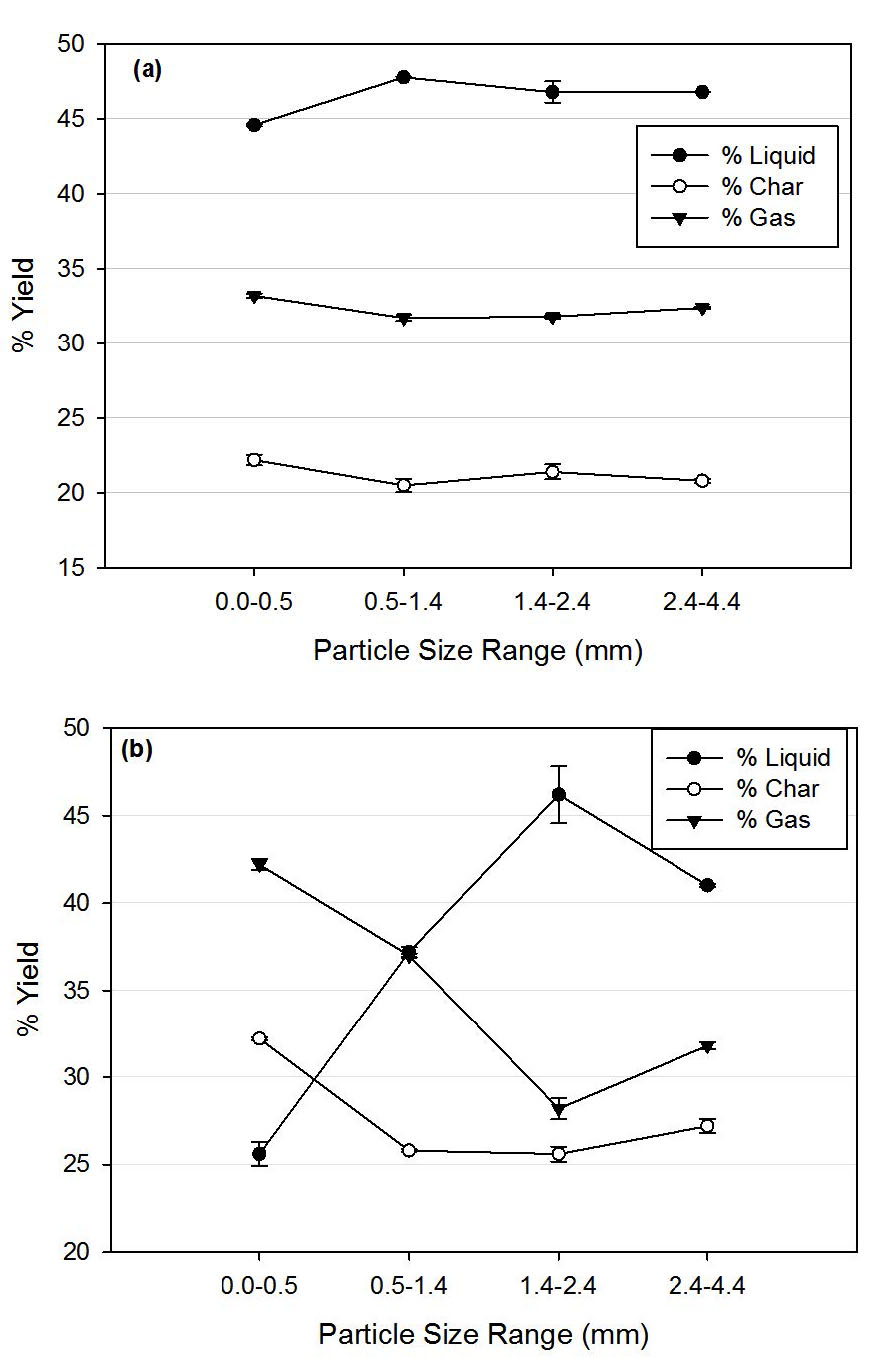 Figure 1. Liquid, char and gas yields of (a) energy cane (top) and (b) CTT (bottom).
Figure 1. Liquid, char and gas yields of (a) energy cane (top) and (b) CTT (bottom).
This observation could be linked to the possibility that at smaller particle sizes (< 0.5mm); the heat transfer rate is higher causing higher overall temperatures. This may result in a more thorough breakdown of biomass and localized superheating of biomass causing fractionation of biomass to form non-condensable gases such as CO and CO2 and decreasing liquid yield [26]. As the particle size increases, the heat transfer rate decreases reducing the effect of local superheating and increases the oil yield. However, particle sizes that are too large may also result in temperature gradient within the particle which may cause increased char yield and lower liquid yield [27].
Occurrence of water in pyrolysis reaction is a result of two main reaction mechanisms; dehydration of biomass structure and inter- or intra- particle secondary cracking of biomass. The dehydration of biomass has been established to be independent of the reaction temperature and particle size as it can occur at temperatures as low as 350 °C throughout the particle size ranges studied here [17]. However, secondary cracking reactions can occur for smaller particle sizes (<0.5mm) (Figure 2).
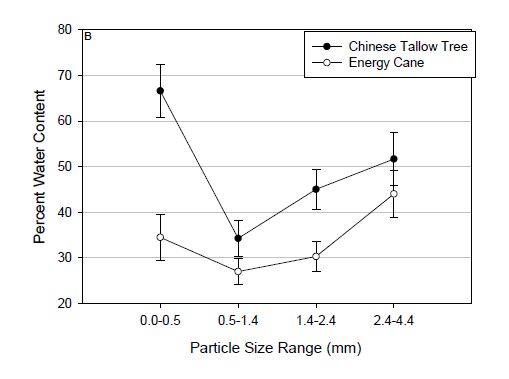 Figure 2. Water content of bio-oil, quantified from Karl-Fischer volumetric titration of liquid oil fraction.
Figure 2. Water content of bio-oil, quantified from Karl-Fischer volumetric titration of liquid oil fraction.
As stated earlier, for particle size < 0.5 mm, the heat transfer rate is high which may result in localized high temperatures causing secondary fractionation reactions. This could be the reason why higher water content was observed at the lowest particle size range. As the particle size increased, the effect of secondary cracking reaction decreased, causing a decrease in water content of liquid fraction. The slight increase in the water content at higher particle sizes could be due to non-uniform initial moisture content of the biomass.
The carbon, hydrogen, nitrogen and oxygen content of bio-oil were analyzed using Perkin Elmer series 2700 elemental analyzer (Figure 3).
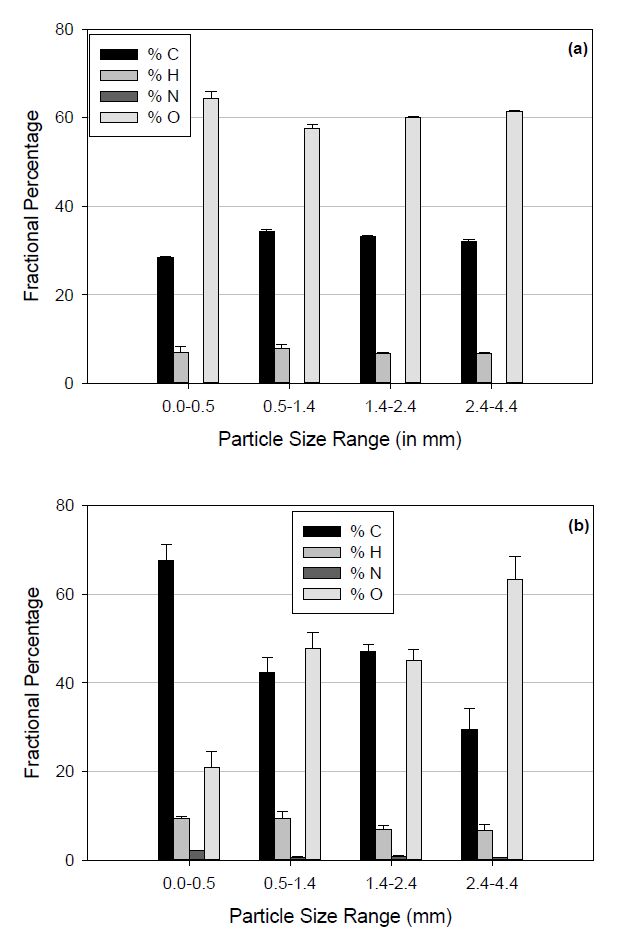 Figure 3. Carbon, Hydrogen, Nitrogen, and Oxygen fractions of oil from (a) Energy cane (top) and (b) Chinese Tallow Tree (bottom).
Figure 3. Carbon, Hydrogen, Nitrogen, and Oxygen fractions of oil from (a) Energy cane (top) and (b) Chinese Tallow Tree (bottom).
Chinese tallow tree bio-oil had higher carbon content compared to energy cane. Highest carbon content was obtained at range A for CTT. No specific trend was observed for carbon or hydrogen content of CTT bio-oil. For energy cane, the carbon content slightly increased with increase in particle size from range A to range B after which a stable value was obtained. The hydrogen content showed a similar trend as that of carbon content for bio-oil obtained from energy cane. The carbon to hydrogen ratio (C/H) varied from 4.0-4.8 for bio-oil obtained from energy cane whereas it was slightly higher (4.0-7.0) for bio oil obtained from CTT at different particle size ranges. The C/H ratio was higher for lower particle sizes which indicates enhanced dehydrogenation reaction and accelerated pyrolysis reaction [26]. Nitrogen was found only in trace amounts in both liquid sample sets, typically less than 0.5% for energy cane and less than 0.9% for CTT. The highest occurrence of note for nitrogen was a measured 2% in CTT from 0.0-0.5 mm.
The oil samples were analyzed for composition using gas chromatograph. The products were identified using mass spectrometer. The composition of the liquid samples remained the same across the particle sizes of each biomass (Figures 4 and 5).
 Figure 4. Chromatograms of energy cane, scaled to largest peak (top) and to a lower value (bottom).
Figure 4. Chromatograms of energy cane, scaled to largest peak (top) and to a lower value (bottom).
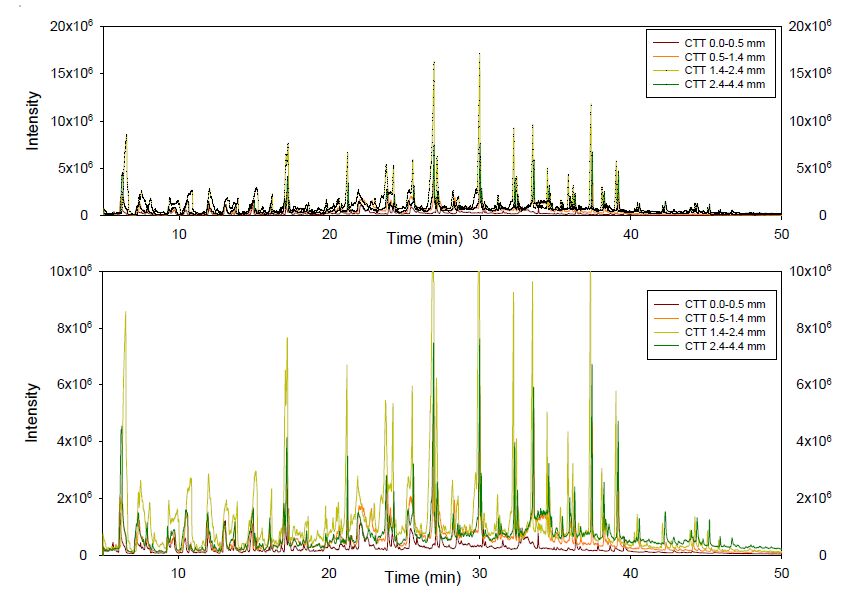 Figure 5. Chromatograms for CTT, scaled to highest peak (top) and to a lower value (bottom).
Figure 5. Chromatograms for CTT, scaled to highest peak (top) and to a lower value (bottom).
The compounds found were typical of pyrolysis of lignocellulosic feedstock [17,28]. The compounds were grouped in six major groups (Figures 6 and 7).
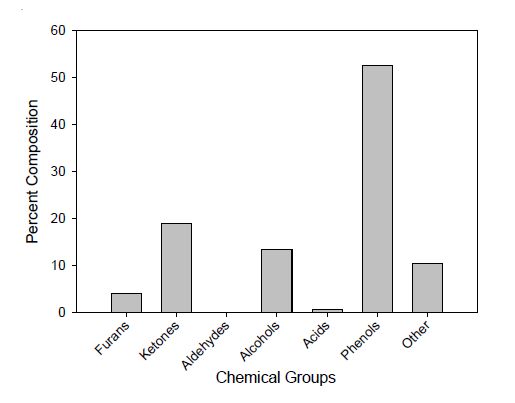 Figure 6. Percent occurrence of identified compounds in energy cane categorized into six major groups; Furans, Ketones, Aldehydes, Alcohols, Acids, Phenols, and Others.
Figure 6. Percent occurrence of identified compounds in energy cane categorized into six major groups; Furans, Ketones, Aldehydes, Alcohols, Acids, Phenols, and Others.
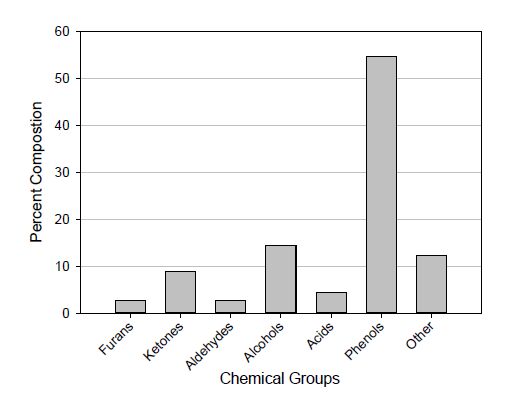 Figure 7. Percent occurrence of identified compounds in CTT categorized into six major groups; Furans, Ketones, Aldehydes, Alcohols, Acids, Phenols, and Others.
Figure 7. Percent occurrence of identified compounds in CTT categorized into six major groups; Furans, Ketones, Aldehydes, Alcohols, Acids, Phenols, and Others.
The data indicates that the highest percentage of compounds found in both oils are phenol and the various phenol variations (Eugenol, Vanillin, Maltol, o-Cresol, p-Cresol, Xylenol, Creosol, Ethylguaiacol, Catechol), followed by ketones as the second highest in energy cane and alcohols as the second highest in CTT. The raw composition of CTT has a higher fatty acid content, which in pyrolysis converts to alcoholic fatty acids resulting in significant increase in acid and alcohol content over energy cane. The raw composition of energy cane has a higher fiber content which accounts for the increased yields of ketones and slight increase of furans over CTT.
In addition to identification and relative quantification of compounds in the liquid fraction described above, the non-condensable and insoluble gas fractions were also analyzed for CO, CO2 and CH4 concentration (Table 1). Even if the hydrogen and C2-C6 were not quantified, literature data shows that the C2-C6 gases are only present in small amounts [26]. The percentage of carbon monoxide and methane increased as the particle size decreased from range D to B. For the lowest particle size range A, no specific trend was observed. However, it must be noted that the hydrogen content was not accounted for in this study. The increase in CO content of gas with the decreasing particle size could be due to enhanced pyrolysis reaction rate for lower particle sizes [26].
| Energy cane | Chinese Tallow Tree | ||||||
| Particle size range (mm) | % CO | % CO2 | % CH4 | Particle size range (mm) | % CO | % CO2 | % CH4 |
| 0.0-0.5 | 20.80 | 5.90 | 2.48 | 0.0-0.5 | 10.02 | 9.07 | 2.49 |
| 0.5-1.4 | 21.77 | 0.93 | 3.00 | 0.5-1.4 | 7.63 | 2.33 | 3.02 |
| 1.4-2.4 | 19.16 | 10.51 | 4.39 | 1.4-2.4 | 1.45 | 0.45 | 1.01 |
| 2.4-4.4 | 16.38 | 1.76 | 3.85 | 2.4-4.4 | 1.28 | 0.49 | 0.62 |
Using eqn. 1, the high heating value of biomass and products was calculated. The bio-oil from CTT had the highest energy content of 32.71 MJ/kg. The HHV of CTT bio-oil decreased as the particle size increased. For energy cane, the HHV value of bio-oil decreased as the particle size decreased, except for the lowest particle size. This could be due to low hydrogen content of thebio-oil at that particle size. The HHV of CTT and energy cane biomasses were found to be 17.48MJ/kg and 17.21 MJ/kg. The energy content of CTT and energy cane char were found to be 23.7MJ/kg and 26.10 MJ/kg for all particle size combinations
The effect of particle size on the pyrolysis of two different biomasses was studied using an advanced induction heating reactor. The products were analyzed for quality and the yields were quantified. By manipulation of the particle size of feedstock biomasses in pyrolysis reactions, it is possible to have some influence on the bio-oil and chars produced from pyrolysis reactions. The effect of particle size was more pronounced for liquid yields from CTT than from energy cane with a maximum yield of 46.20% from the 1.4-2.4 mm range. Gas yields decreased as the particle size increased as lower particle size biomass were more thoroughly broken down. The GC-MS results show that the bio-oil composition did not change significantly with the change in particle size. Particle size variation had a significant effect on the water content of the bio-oil, with very high water content at lowest particle size. However, initial moisture content of the biomass also plays an important role in the final water bio-oil water content. Energy cane bio-oil saw little variation in the CHNO composition across all four ranges. These manipulations will be useful in optimizing the pyrolysis process for larger or commercial grade pyrolysis oil production, especially when used in unison with temperature optimization and upgrading techniques to reduce cost, simplifying processing, and create high value products.
The authors would like to acknowledge the LSU Agricultural Center and LSU Biological and Agricultural Engineering Department for their support of this project. The author acknowledges Grant-In-Aid ofResearch from Sigma Xi, The Scientific Research Society (award #G201503151139459). Partial funding for this project was provided by a USDA Hatch Program (#LAB 94196) and National Science Foundation CBET (award #1437810). Published with the approval of the Director of the Louisiana Agricultural Experiment Station as manuscript #2015-232-22704. The authors extend their acknowledgement to Charles Milan, Connie David, Jeff Corkern, and Thomas Blanchard for their technical support.
All authors declare no conflicts of interest in this paper.
| [1] | Muley PD, Henkel C, Abdollahi KK, et al. (2015) Pyrolysis and Catalytic Upgrading of Pinewood Sawdust Using Induction Heating Reactor. Energ Fuel. |
| [2] | Urbatsch L (2000) Chinese tallow tree (Triadica sebifera (L.) Small. Plant Guide. Natural Resources Conservation Service (NRCS). |
| [3] |
Heo HS, Park HJ, Park Y-K, et al. (2010) Bio-oil production from fast pyrolysis of waste furniture sawdust in a fluidized bed. Bioresource technol 101: S91-S96. doi: 10.1016/j.biortech.2009.06.003

|
| [4] |
Lu Q, Yang Xl, Zhu Xf (2008) Analysis on chemical and physical properties of bio-oil pyrolyzed from rice husk. J Anal Appl Pyrol 82: 191-198. doi: 10.1016/j.jaap.2008.03.003

|
| [5] |
McKendry P (2002) Energy production from biomass (part 2): conversion technologies. Bioresource Technol 83: 47-54. doi: 10.1016/S0960-8524(01)00119-5

|
| [6] |
Mohan D, Pittman CU, Steele PH (2006) Pyrolysis of Wood/Biomass for Bio-oil: A Critical Review. Energ Fuel 20: 848-889. doi: 10.1021/ef0502397

|
| [7] |
Bergström D, Israelsson S, ñhman M, et al. (2008) Effects of raw material particle size distribution on the characteristics of Scots pine sawdust fuel pellets. Fuel Process Technol 89: 1324-1329. doi: 10.1016/j.fuproc.2008.06.001

|
| [8] |
Liao R, Gao B, Fang J (2013) Invasive plants as feedstock for biochar and bioenergy production. Bioresource technol 140: 439-442. doi: 10.1016/j.biortech.2013.04.117

|
| [9] |
Bridgwater AV, Meier D, Radlein D (1999) An overview of fast pyrolysis of biomass. Org Geochem 30: 1479-1493. doi: 10.1016/S0146-6380(99)00120-5

|
| [10] |
Tsai WT, Lee MK, Chang YM (2006) Fast pyrolysis of rice straw, sugarcane bagasse and coconut shell in an induction-heating reactor. J Anal Appl Pyrol 76: 230-237. doi: 10.1016/j.jaap.2005.11.007

|
| [11] |
Uzun BB, Kanmaz G (2013) Effect of operating parameters on bio-fuel production from waste furniture sawdust. Waste Manage Res 31: 361-367. doi: 10.1177/0734242X12470402

|
| [12] |
Ateş F, Pütün E, Pütün AE (2004) Fast pyrolysis of sesame stalk: yields and structural analysis of bio-oil. J Anal Appl Pyrol 71: 779-790. doi: 10.1016/j.jaap.2003.11.001

|
| [13] |
Miao Z, Grift TE, Hansen AC, et al. (2011) Energy requirement for comminution of biomass in relation to particle physical properties. Ind Crop Prod 33: 504-513. doi: 10.1016/j.indcrop.2010.12.016

|
| [14] | Onay ñ (2003) Production of Bio-Oil from Biomass: Slow Pyrolysis of Rapeseed (Brassica napus L.) in a Fixed-Bed Reactor. Energ Sources 25: 879-892. |
| [15] | Şensöz S, Angın D, Yorgun S (2000) Influence of particle size on the pyrolysis of rapeseed (Brassica napus L.): fuel properties of bio-oil. Biomass Bioenerg 19: 271-279. |
| [16] |
Rhén C, Gref R, Sjöström M, et al. (2005) Effects of raw material moisture content, densification pressure and temperature on some properties of Norway spruce pellets. Fuel Process Technol 87: 11-16. doi: 10.1016/j.fuproc.2005.03.003

|
| [17] |
Shen J, Wang XS, Garcia-Perez M, et al. (2009) Effects of particle size on the fast pyrolysis of oil mallee woody biomass. Fuel 88: 1810-1817. doi: 10.1016/j.fuel.2009.05.001

|
| [18] |
Bennadji H, Smith K, Serapiglia MJ, et al. (2014) Effect of Particle Size on Low-Temperature Pyrolysis of Woody Biomass. Energ Fuel 28: 7527-7537. doi: 10.1021/ef501869e

|
| [19] | Kim M, Day DF (2011) Composition of sugar cane, energy cane, and sweet sorghum suitable for ethanol production at Louisiana sugar mills. J Ind Microbiol Biot38: 803-807. |
| [20] | Jubinsky G, Anderson LC (1996) The invasive potential of Chinese tallow-tree (Sapium sebiferum Roxb.) in the Southeast. Castanea: 226-231. |
| [21] | Fennell LP, Boldor D (2013) Dielectric characterization of the seeds of invasive Chinese Tallow Tree. J Microwave Power EE 47: 237-250. |
| [22] | Henkel C (2014) A Study of Induction Pyrolysis of Lignocellulosic Biomass for the Production of Bio-oil: Louisiana State University. |
| [23] |
Bedmutha RJ, Ferrante L, Briens C, et al. (2009) Single and two-stage electrostatic demisters for biomass pyrolysis application. Chem Eng Process: Process Intensification 48: 1112-1120. doi: 10.1016/j.cep.2009.02.007

|
| [24] | Scholze B, Meier D (2001) Characterization of the water-insoluble fraction from pyrolysis oil (pyrolytic lignin). Part I. PY-GC/MS, FTIR, and functional groups. J Anal Appl Pyrol 60: 41-54. |
| [25] |
Demirbas A, Demirbas H (2004) Estimating the Calorific Values of Lignocellulosic Fuels. Energ Explor Exploit 22: 135. doi: 10.1260/0144598041475198

|
| [26] |
Luo S, Xiao B, Hu Z, et al. (2010) Effect of particle size on pyrolysis of single-component municipal solid waste in fixed bed reactor. Int J Hydrogen Energ 35: 93-97. doi: 10.1016/j.ijhydene.2009.10.048

|
| [27] |
Vamvuka D, Kakaras E, Kastanaki E, et al. (2003) Pyrolysis characteristics and kinetics of biomass residuals mixtures with lignite. Fuel 82: 1949-1960. doi: 10.1016/S0016-2361(03)00153-4

|
| [28] |
Jung SH, Kang BS, Kim JS (2008) Production of bio-oil from rice straw and bamboo sawdust under various reaction conditions in a fast pyrolysis plant equipped with a fluidized bed and a char separation system. J Anal Appl Pyrol 82: 240-247. doi: 10.1016/j.jaap.2008.04.001

|
| 1. | T. E. Odetoye, J. O. Titiloye, 2020, Chapter 15, 978-3-030-38031-1, 303, 10.1007/978-3-030-38032-8_15 | |
| 2. | Dideolu J. Daniel, Candice R. Ellison, Jacob Bursavich, McKenna Benbow, Caroline Favrot, Michael A. Blazier, Cosmin Marculescu, Sue E. Nokes, Dorin Boldor, An evaluative comparison of lignocellulosic pyrolysis products derived from various parts of Populus deltoides trees and Panicum virgatum grass in an inductively heated reactor, 2018, 171, 01968904, 710, 10.1016/j.enconman.2018.06.026 | |
| 3. | Longwen Ou, Hao Cai, Dynamic Life-Cycle Analysis of Fast Pyrolysis Biorefineries: Impacts of Feedstock Moisture Content and Particle Size, 2020, 8, 2168-0485, 6211, 10.1021/acssuschemeng.9b06836 | |
| 4. | Xianhui Zhao, Halil Tekinalp, Xianzhi Meng, Darby Ker, Bowie Benson, Yunqiao Pu, Arthur J. Ragauskas, Yu Wang, Kai Li, Erin Webb, Douglas J. Gardner, James Anderson, Soydan Ozcan, Poplar as Biofiber Reinforcement in Composites for Large-Scale 3D Printing, 2019, 2, 2576-6422, 4557, 10.1021/acsabm.9b00675 | |
| 5. | Emi Erawati, Rosyad Adrian Febriansyar, Pyrolysis Kinetics of Mixture Polypropylene and High Density Polyethylene Plastic Wastes Using Kaolin Catalyst, 2020, 998, 1662-9752, 114, 10.4028/www.scientific.net/MSF.998.114 | |
| 6. | A.M. Shoaib, R.A. El-Adly, M.H.M. Hassanean, A. Youssry, A.A. Bhran, Developing a free-fall reactor for rice straw fast pyrolysis to produce bio-products, 2018, 27, 11100621, 1305, 10.1016/j.ejpe.2018.08.002 | |
| 7. | Muhammad Zain Siddiqui, Mahshab Sheraz, Umair Ali Toor, Ali Anus, Abid Mahmood, Muhammad Haseeb, Muhammad Ibrahim, Kuan Shiong Khoo, Vishno Vardhan Devadas, Muhammad Mubashir, Sami Ullah, Pau Loke Show, Recent approaches on the optimization of biomass gasification process parameters for product H2 and syngas ratio: a review, 2022, 1387-585X, 10.1007/s10668-022-02279-6 | |
| 8. | Habu Iyodo Mohammed, Kabir Garba, Saeed Isa Ahmed, Lawan Garba Abubakar, Recent advances on strategies for upgrading biomass pyrolysis vapour to value-added bio-oils for bioenergy and chemicals, 2023, 55, 22131388, 102984, 10.1016/j.seta.2022.102984 | |
| 9. | Tahereh Sarchami, Neha Batta, Franco Berruti, Production and separation of acetic acid from pyrolysis oil of lignocellulosic biomass: a review, 2021, 15, 1932-104X, 1912, 10.1002/bbb.2273 | |
| 10. | Azharuddin Farooqui, Amr Abdalla, Nader Mahinpey, 2023, 9780323918718, 47, 10.1016/B978-0-323-91871-8.00024-6 | |
| 11. | Obianuju Patience Ilo, S’phumelele Lucky Nkomo, Ntandoyenkosi Malusi Mkhize, Onisimo Mutanga, Mulala Danny Simatele, Optimisation of process parameters using response surface methodology to improve the liquid fraction yield from pyrolysis of water hyacinth, 2023, 30, 0944-1344, 6681, 10.1007/s11356-022-22639-z | |
| 12. | Elena Butnaru, Daniela Pamfil, Elena Stoleru, Mihai Brebu, Characterization of bark, needles and cones from silver fir (Abies alba mill.) towards valorization of biomass forestry residues, 2022, 159, 09619534, 106413, 10.1016/j.biombioe.2022.106413 | |
| 13. | Khan Muhammad Qureshi, Andrew Ng Kay Lup, Saima Khan, Faisal Abnisa, Wan Mohd Ashri Wan Daud, Optimization of palm shell pyrolysis parameters in helical screw fluidized bed reactor: Effect of particle size, pyrolysis time and vapor residence time, 2021, 4, 26667908, 100174, 10.1016/j.clet.2021.100174 | |
| 14. | Răzvan Nicolae State, Gabriela Ionescu, Mariana Pătrașcu, Adrian Volceanov, Dorin Boldor, Cosmin Mărculescu, Twin reactor catalytic assisted pyrolysis for food court waste conversion into high end chemicals, 2021, 160, 01652370, 105351, 10.1016/j.jaap.2021.105351 | |
| 15. | Elena Butnaru, Daniela Pamfil, Elena Stoleru, Mihai Brebu, Characterization of Bark, Needles and Cones from Silver Fir (Abies Alba Mill.) Towards Valorization of Biomass Forestry Residues, 2022, 1556-5068, 10.2139/ssrn.4002863 | |
| 16. | Thuan Anh Vo, Jinsoo Kim, Hyun Tae Hwang, Seung-Soo Kim, Fast pyrolysis of cashew nut shells in a bubbling fluidized bed reactor for producing high-heating value bio-oil using dolomite as a catalyst and carbon capture sorbent, 2024, 364, 00162361, 131024, 10.1016/j.fuel.2024.131024 | |
| 17. | Bidhan Nath, Guangnan Chen, Les Bowtell, Thong Nguyen‐Huy, Pyrolysis of wheat straw pellets in a pilot‐scale reactor: Effect of temperature and residence time, 2024, 12, 2050-0505, 3524, 10.1002/ese3.1833 | |
| 18. | Habu Iyodo Mohammed, Kabir Garba, Saeed I. Ahmed, Lawan G. Abubakar, Pyrolysis of hyphaene thebaica shell over ceramic tile dust-derived catalysts and assessment of the produced bio-oil, 2024, 2, 29497507, 64, 10.1016/j.wmb.2024.08.009 | |
| 19. | Md Reza, Zhanar Iskakova, Shammya Afroze, Kairat Kuterbekov, Asset Kabyshev, Kenzhebatyr Bekmyrza, Marzhan Kubenova, Muhammad Bakar, Abul Azad, Hridoy Roy, Md Islam, Influence of Catalyst on the Yield and Quality of Bio-Oil for the Catalytic Pyrolysis of Biomass: A Comprehensive Review, 2023, 16, 1996-1073, 5547, 10.3390/en16145547 |
| Energy cane | Chinese Tallow Tree | ||||||
| Particle size range (mm) | % CO | % CO2 | % CH4 | Particle size range (mm) | % CO | % CO2 | % CH4 |
| 0.0-0.5 | 20.80 | 5.90 | 2.48 | 0.0-0.5 | 10.02 | 9.07 | 2.49 |
| 0.5-1.4 | 21.77 | 0.93 | 3.00 | 0.5-1.4 | 7.63 | 2.33 | 3.02 |
| 1.4-2.4 | 19.16 | 10.51 | 4.39 | 1.4-2.4 | 1.45 | 0.45 | 1.01 |
| 2.4-4.4 | 16.38 | 1.76 | 3.85 | 2.4-4.4 | 1.28 | 0.49 | 0.62 |